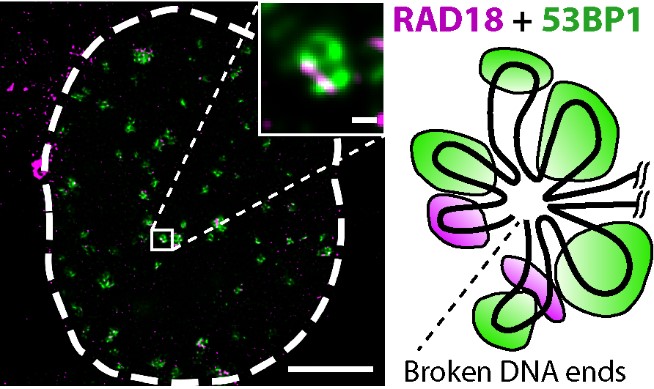
New function identified for an old protein in DNA repair
03. 07. 2024
Scientists from Institute of Molecular Genetics of the Czech Academy of Sciences identified new mechanisms of DNA repair in human cells. They found that RAD18 protein controls the choice of specific pathways used for repair of the DNA breaks and prevent development of genome instability that is one of the hallmarks of cancer. These new findings have recently been published in Nucleic Acids Research journal.
Genetic information encoded in the DNA is continuously damaged by various factors. Our cells protect themselves by efficiently repairing all lesions. Depending on the cell cycle phase, cells repair the breaks either by simply pasting both free ends of the rope together (so called NHEJ) or by a more complex process involving reconstruction of the damaged strand by copying an intact DNA template (so called homologous recombination).
The second process is much more precise but can act only when two copies of DNA are available. Mechanisms that govern selection of the correct DNA repair pathway are intensively studied as they represent potential targets for personalized cancer treatment. We have now found that RAD18 recognizes specific epigenetic marks in the chromatin, promotes recruitment of several other proteins to the duplicated DNA and thus allows cells to repair DNA lesions through the error-free homologous recombination. "Using high resolution 3D-SIM microscopy, we observed RAD18 enrichment at the DNA breaks, and displacement of 53BP1 protein to the periphery, which suppressed inaccurate repair by ligation of DNA ends," says the first author Matouš Palek.
Thanks to the support by Ministry of Health and National Institute of Cancer Research we established a collaboration with the CZECANCA consortium led by Prof. Zdenek Kleibl and identified several RAD18 mutations in Czech cancer patients. Interestingly, some of these RAD18 mutations failed to promote DNA repair suggesting that they may contribute to genome instability which is an important driving force in cancer development. In the last decades, protein RAD18 has been implicated in cellular responses to UV light. We have now discovered a new layer of delicate regulation of DNA repair in human cells. “Contribution of the defects in RAD18 function to cancer and sensitivity to treatment will be a subject of our future research,” says Libor Macůrek, leader of the research team.
Contact:
Libor Macurek
IMG, Prague
libor.macurek@img.cas.cz
Link to the publication:
Palek M, Palkova N; consortium CZECANCA; Kleiblova P, Kleibl Z, Macurek L. RAD18 directs DNA double-strand break repair by homologous recombination to post-replicative chromatin. Nucleic Acids Res. 2024 Jun 13:gkae499. doi: 10.1093/nar/gkae499. Epub ahead of print. PMID: 38884202. https://academic.oup.com/nar/advance-article/doi/10.1093/nar/gkae499/7694281?login=true

High-resolution 3D-SIM microscopy image. View of a cell nucleus (outlined in dashed lines) exposed to ionizing radiation. RAD18 is at the site of DNA damage (purple), while 53BP1 is pushed to the edge (green).
Download the press release here.
Read also
- Scholars from the Czech Academy of Sciences will help make key UN documents on refugee policy in post-communist Europe accessible
- New perspective on the climate crisis: an ERC Consolidator grant
- World first for Czech science: egg ageing can be reversed
- How the human genome duplicates. A Czech becomes a new EMBO Young Investigator
- For the First Time Ever, a Czech Scientist Wins the international Dream Chemistry Award
- AI recognises parasitic eggs better than the average ornithologist
- IOCB researchers take a key step toward fully controllable molecular machines
- Two of Europe´s most prestigious grants awarded to the Czech Academy od Sciences
- Czech scientists discover a cellular “safety switch” that protects DNA from damage
- Fungi may use toxic substances to spread skin infections from guinea pigs to children
Contacts for Media
Markéta Růžičková
Public Relations Manager
+420 777 970 812
Eliška Zvolánková
+420 739 535 007
Martina Spěváčková
+420 733 697 112